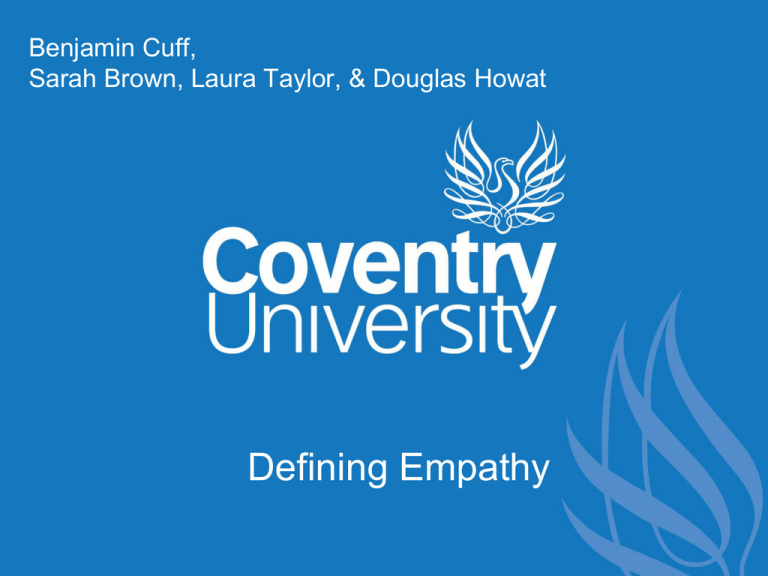
Benjamin Cuff,
Sarah Brown, Laura Taylor, & Douglas Howat
Defining Empathy
Introduction
• Doctoral research exploring the
measurement of empathy
• Confusion over the definition of empathy
– “There are probably nearly as many definitions
of empathy as people working on the topic.”
– de Vignemont & Singer (2006, p.435)
Implications
• Affects our understanding of the concept
• Research
– Comparing research findings
– Measurement
• Treatment
– Counsellors - Clark (2010)
– Developer / practitioner differences
Literature Review
• 40 distinct definitions identified
– (but there are many more!)
• Thematic analysis – 7 common areas of
confusion
Cognitive or Affective?
• Cognitive empathy = understanding another’s emotions
• Affective empathy = experiencing another’s emotions
• Extensive evidence to demonstrate the existence of both
but to separate them completely reflects a “false
dichotomy” (Duan & Hill, 1996, p.263).
• Despite history of this debate, definitions still omit one
or the other.
– 14 / 40
Suggestion: Acknowledge both & interaction.
Congruent or Incongruent?
• Are emotions in the observer and target the same?
– “sharing”; “experiencing vicariously”
• 12 / 40
• Congruency necessary to separate empathy
(congruent) from sympathy (incongruent).
• Exact matching is highly unlikely.
– Dependent on a range of factors.
Suggestion: Congruent with the perceived emotion.
Subject to Other Stimuli?
• Direct perception necessary
– 8 / 40
• Three possible alternatives:
– A present but non-emotional target (Pithers, 1999)
– Absent target (Blair, 2005; Polaschek, 2003)
– Imagined / fictional target (Singer & Lamm, 2009)
• Key element:
– Perception of emotionality
• Whether stimulus is real, present, imagined, absent
Suggestion: Do not limit to direct perception.
Self-Other Distinction or Merging?
• 3 / 40: “Clear” distinction necessary.
– Awareness that the emotion comes from an
external source
• Separation from emotional contagion.
• Total distinction?
– Some merging necessary to share emotions.
• Provides a “bridge” between self and other.
– (Decety & Sommerville, 2003).
Suggestion: Do not imply complete distinction.
Trait or State Influences?
• Empathy = trait concept
– “Ability”; “Capacity”
• 11 / 40
– Differences in grey matter volume (Banissy et al., 2012)
– Population differences (Blair, 2005; Baron-Cohen &
Wheelwright, 2004)
• Empathy = state concept
– Victim specific deficits in offenders (Marshall et al., 1995).
– Cognitive factors.
– General lack of research into these factors.
Suggestion: A combination of both.
Has a Behavioural Outcome?
• Empathy has a behavioural component.
– 4 / 40
• Not always.
– Cases of inaction.
• Not in the immediate sense.
– Mediated through sympathy.
Suggestion: Omit behavioural outcomes from
empathy definitions (or limit to behavioural
motivations).
Synonymous With Other Concepts?
• An umbrella term?
– Empathy = emotional contagion, sympathy, compassion etc.
– 2 / 40
• Confusion with sympathy
– 11 / 40
– Functional differences
• “Feeling as and feeling for” (Hein & Singer, 2008, p.157)
– Neurological differences (Decety & Michalska, 2010)
• Confusion with other concepts
– Tenderness = sympathy towards vulnerability.
– Compassion = sympathy?
Suggestion: Keep related concepts separate.
A New Definition of Empathy
Empathy is a state and trait emotional response
(affective), congruent with one’s understanding
(cognitive) of another’s emotions (either through
direct perception or imagination), with recognition
that the source of the emotion is not one’s own.
• Adheres to all suggestions presented previously.
• Some final thoughts:
– Use of evidence when defining empathy.
– Greater consistency in both research and practice.
• cuffb@uni.coventry.ac.uk
• Any Questions?
References
•
•
•
•
•
•
•
•
Banissy, M. J., Kanai, R., Walsh, V., & Rees, G. (2012). Inter-individual differences in empathy are
reflected in human brain structure. NeuroImage, 62, 2034-2039.
Baron-Cohen, S., & Wheelwright, S. (2004). The empathy quotient: An investigation of adults with asperger
syndrome or high functioning autism, and normal sex differences. Journal of Autism and Developmental
Disorders, 34(2), 163-175.
Blair, R. J. R. (2005). Responding to the emotions of others: Dissociating forms of empathy through the
study of typicaland psychiatric populations. Consciousness and Cognition, 14, 698-718.
Clark, A.J. (2010). Empathy and sympathy: Therapeutic distinctions in counseling. Journal of Mental Health
Counseling, 32(2), 95-101.
Decety, J., & Michalska, K. J. (2010). Neurodevelopmental changes in the circuits underlying empathy and
sympathy from childhood to adulthood. Developmental Science, 13(6), 886-899.
Decety, J., & Sommerville, J. A. (2003). Shared representations between self and other: A social cognitive
neuroscience view. Trends in Cognitive Sciences, 7(12), 527-533. doi: 10.1016/j.tics.2003.10.004
de Vignemont, F., & Singer, T. (2006). The empathic brain: How, when and why? Trends in Cognitive
Sciences, 10, 435-441.
Duan, C., & Hill, C. E. (1996). The current state of empathy research. Journal of Counseling Psychology,
43(3), 261-274.
References
•
•
•
•
•
•
Hein, G., & Singer, T. (2008). I feel how you feel but not always: The empathic brain and its modulation.
Current Opinion in Neurobiology, 18, 153-158.
Marshall, W. L., Hudson, S. M., Jones, R., & Fernandez, Y. M. (1995). Empathy in sex offenders. Clinical
Psychology Review, 15, 99-113.
Pithers, W. D. (1999). Empathy: Definition, enhancement, and relevance to the treatment of sexual
abusers. Journal of Interpersonal Violence, 14(3), 257-284.
Polaschek, D. L. L. (2003). Empathy and victim empathy. In T. Ward, D. R. Laws & S. M. Hudson (Eds.),
Sexual deviance: Issues and controversies (pp. 172-189). Thousand Oaks, CA: Sage.
Singer, T., & Lamm, C. (2009). The social neuroscience of empathy. Annals of the New York Academy of
Sciences, 1156, 81-96.
Singer, T., Seymour, B., O’Doherty, J. P., Stephen, K. E., Dolan, R. J., & Frith, C. D. (2006). Empathic
neural responses are modulated by the perceived fairness of others. Nature, 439, 466-469.










